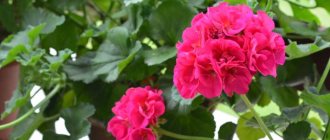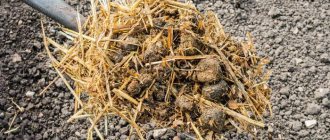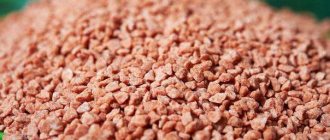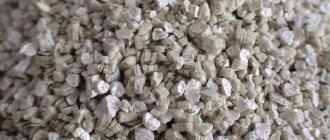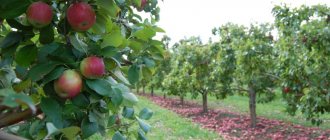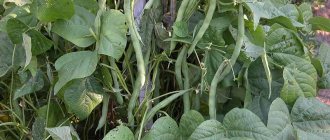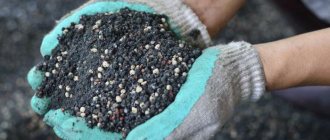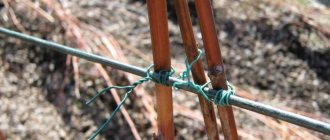Currently, to generate high yields and maintain soil fertility, summer residents everywhere use available mineral fertilizers, which contain elements removed from the soil by the harvest. You need to know that fertilizers provide only a short-term increase in crop yields, while simultaneously reducing the amount of humus in the soil, that is, the natural fertility of the soil. In recent years, the ranks of landowners who have switched to ecological farming have been growing. The basis of ecology in this case is the use in everyday life of only natural products, the production of which is impossible without returning to Mother Earth those substances that were taken away by the harvest. A worthy substitute for “chemical well-being” are natural fertilizers - waste from animals that eat plant foods. Manure is such an organic fertilizer.
Compost from rotted manure. © dasuns
How do organic fertilizers differ from mineral fertilizers?
Mineral fertilizers are produced at chemical plants and, when applied to the soil, are a foreign substance for plants that must be converted into an accessible form of use.
- To become available to plants, elements of nutrient salts must be converted into chelate form.
- Mineral fertilizers contain only a narrow list of chemical elements necessary for plants.
- Fertilizers are applied to the soil taking into account its parameters and the needs of plants.
- Mineral fertilizers do not contribute to the formation of humus, which reduces natural soil fertility.
Nutrients from organic fertilizers are more accessible to plants, since they are a product of the vital activity of animals, and in the ecosystem it is its natural element. The only limitation in farming: due to improper agricultural practices, nitrites accumulate in fruits and vegetables. When processed, organic waste forms humus, which determines the level of soil fertility.
Cattle manure
The excrement of cows and other cattle is low in nitrogen and organic matter. This material has high humidity. These features make such waste suitable for the production of humus. But cow dung is not suitable for the production of fuel briquettes. You will have to spend a lot of energy on the drying process. This type of excrement is also not suitable for the production of pyrolysis and biogas, or the production of insulation.
To obtain humus, the biomass is piled up and treated with special compounds containing bifidobacteria. Microorganisms actively process the material. During this process, the manure is heated to 40-60°C. It is desirable that the litter be based on crushed plants. This compensates for the lack of organic matter, and the finished humus will better loosen the soil.
Types of manure and its features
The following types of manure are obtained from animals:
- cow (mullein);
- horse;
- pork;
- avian (chicken);
- rabbit;
- sheep, etc.
Each type of manure has its own characteristics and composition, and differs in the duration of its effect on the soil.
Efficiency of cow manure : it shows its greatest effectiveness within 2-3 years on light sandy and sandy loam soils and 4-6 years on heavy clay soils.
Bird droppings take a year to decompose. This is the fastest acting organic fertilizer. It is convenient to use in fertilizing. However, the concentration of bird droppings is so high that its use as fertilizer is possible only when diluted 10-12 times.
Horse manure is one of the best. Porous structure and rich chemical composition, high decomposition temperature, it is most effective when used in open ground and greenhouses. Due to the mechanization of agriculture, the amount of horse manure on farms has decreased significantly. It has become less available than mullein.
Pig manure is used to a lesser extent by gardeners. It contains a high nitrogen content (acrid ammonia smell) and a large number of helminths. It cannot be used fresh. Usually mixed with horseweed, dolomite flour is added, composted for a year for natural disinfection (from helminths) and only then applied to the soil. Pig manure is good because it has a high decomposition temperature. In combination with horse compost, high-quality compost is obtained after a year of fermentation.
If necessary, use manure from other animals and birds to improve soil indicators and increase soil fertility.
Chicken droppings. © Shane Barlow
Horse manure. © Melodie M. Davis
Cow dung. © Richard Lewis
Fertilizing plants with cow manure
Many summer residents believe that cow manure is the best fertilizer. It is actually one of the most popular and versatile organic fertilizers with maximum nitrogen content .
| Advantages: | Flaws: |
|
|
Cow manure is used to feed the following crops:
- cucumbers;
- tomatoes;
- cabbage;
- pepper;
- potatoes;
- fruit trees and shrubs;
- roses and other perennials.
Fresh mullein is not added to beds with root vegetables (turnips, carrots, radishes), kohlrabi and Chinese cabbage, garlic, onions and legumes. Depending on the degree of decomposition, several types of cow manure are distinguished:
- fresh manure (the litter is unchanged and is applied immediately);
- half-rotted manure (the litter has begun to decompose and has low tensile strength);
- rotted manure (very darkened, the litter is easily destroyed);
- humus (the fertilizer compacted and became homogeneous);
- dry dung (basis for preparing infusions and foliar feeding).
The best time to apply cow manure is autumn . With winter feeding, manure gradually decomposes over the winter months and evenly feeds the soil and plant roots. For this purpose, manure is spread evenly over the area at the rate of 6 kg per 1 sq.m of soil and the soil is dug up.
Beneficial properties of manure
The basis of manure is the excrement of various animals mixed with bedding (straw, grass, sawdust and other plant debris). Based on the degree of decomposition, manure can be divided into 3 categories:
- fresh manure, littered and without litter;
- slurry;
- half-rotted manure;
- rotted manure, or humus.
Fresh manure without bedding, not diluted with water - thick, non-flowing, with the consistency of homemade sour cream (can be cut with a knife like butter).
Fresh bedding manure easily holds its given shape, mixed with straw or other materials (sawdust, small shavings).
Slurry has a less concentrated composition than fresh manure. Basically, this is a nitrogen-potassium liquid fertilizer, which is used for fertilizing all garden, berry and vegetable crops. To avoid burning the plants, the slurry is diluted in a ratio of 1:5-6. Apply after watering. Used for moistening when laying compost.
Semi-rotted is one that has lain in the open air for some time (3-6 months), partially dried out and decomposed. The litter is rotten and crumbles easily in your hands. It is used as the main fertilizer for digging, especially on humus-depleted soils.
Humus is a completely rotted granular mass in which the individual components of litter and other inclusions are not visible. The most common natural fertilizer used by summer residents.
Humus content of nutrients and nitrogen, compared to fresh manure, is 2-3 times less, which allows it to be used directly during the growing season of plants for feeding.
Humus based on manure. © Jill&Andy
What is manure
Most often, Russian gardeners and gardeners use cow manure, and as a complex fertilizer. In addition to excrement, it contains straw, peat or other litter, which can account for up to 50% of the total volume. This is the so-called litter type. There is also a beddingless one, which has a completely different composition, method, and area of application.
The most famous organic fertilizer in Russia
It has been used as an organic fertilizer since ancient times in all countries where people were engaged in agriculture. This was one of the best ways to restore the nutritional value of the soil and its fertility. Over many millennia, a wealth of practical experience in application has accumulated. For example, it was noticed that fresh manure inhibits plant growth. And rotted ones can affect the harvest and improve the soil structure.
No one kept any calculations at a time when only organic fertilizers were known, but there are statistics for the 60s of the last century. At this time, mineral fertilizers were already widely used. And yet, about 500 million tons of cow waste were transported to the fields. Collective farm harvests were then distinguished by stable, high rates.
Considerable credit goes to the use of organic fertilizers.
Elephant Waste Paper
In addition, dried excrement was used instead of firewood for heating the home and cooking. This is the so-called dung mixed with straw, dry sheep, yak or buffalo manure. It is still used in some areas of Asia and the East. Manure was also used for the construction of so-called adobe buildings and was used in the manufacture of paper. Paper is still made from elephant dung in Thailand.
Content of basic nutrients in manure
Manure contains components that provide nutrition to plants, improve the physical and chemical properties of the soil, and its structure. Being a source of organic matter, manure during fermentation forms humus compounds that increase the natural fertility of the soil.
Manure in any condition (fresh, semi-rotted, humus) is a source of macro- and microelements, such as nitrogen, phosphorus, potassium, calcium, silicon, sulfur, chlorine, magnesium, boron, manganese, cobalt, copper, zinc, molybdenum. Active microorganisms in manure are the main source of energy for soil microflora.
All types of manure are distinguished by alkaline properties, the alkalinity indicator reaches pH = 8-9 units. In cow manure it is 8.1, in horse manure - 7.8, in pig manure - 7.9 units. Naturally, their application alkalizes the soil, reducing acidity. The content of basic nutrients is presented in the average indicators in Table 1.
Table 1. Chemical composition of the main types of manure and litter
| Manure, droppings | Content, g/kg manure mass | |||
| nitrogen | phosphorus | potassium | calcium | |
| Cow (mullein) | 3,5 | 3,0 | 1,4 | 2,9 |
| Horse | 4,7 | 3,8 | 2,0 | 3,5 |
| Pork | 8,1 | 7,9 | 4,5 | 7,7 |
| Avian (chicken) | 16,0 | 13,0 | 8,0 | 24,0 |
Benefit (chemical composition)
Manure contains large quantities of elements such as nitrogen, phosphorus, potassium, calcium and others. The highest concentration of nitrogen is in chicken manure, followed by rabbit manure. Second place is shared between sheep and goats, third place is taken by horse manure. In last place is pig manure.
Manure with straw
Magnesium and potassium are most abundant in sheep manure. All other types of these elements contain approximately equal amounts. But phosphorus compounds, on the contrary, are most abundant in pork. Its concentration is twice the content of this element in cow manure. The content of phosphorus is close to that of pig manure. This fact once again justifies the theory that the quality of manure depends on several parameters:
- animal species
- gender
- age
- litter content
- degree of overheating
With litter, the content of useful substances changes slightly downward (depending on the amount of litter) and only potassium levels, on the contrary, increase. The bedding can be straw, peat, and sometimes sawdust (partially). Depending on the type of litter, the chemical composition also changes. The “richest” straw litter, peat litter, has low nutritional value.
The quality of manure depends on the type of farm animals, as well as the feed they consumed. If the feed consists of roughage such as straw, hay, grass, vegetables, then the quality of the final product deteriorates. When feeding with mixed feed, the nutritional value, on the contrary, increases.
Manure is rarely used fresh (from 0 to 2-3 months). Most often, semi-rotted (from 3 months to six months), rotted (six months to a year) manure or humus (stored for more than a year) is used in vegetable gardens and orchards. When properly stored, its value as a fertilizer does not decrease.
Manure use
Unlike mineral fertilizers, the nutrient content in organic fertilizers is much lower, but organics improve the physical and chemical properties of the soil, loosen it, increase absorption capacity, enrich it with beneficial microflora, and provide plants with the necessary nutrients in an accessible, easily digestible form.
Table 2. Manure application rate
| Manure, droppings | Apply to the soil, kg/sq. m area |
| Cow (mullein) | 7-10 kg/m² |
| Horse | 3-5 kg/m² |
| Pork | 4-6 kg/m² Some gardeners recommend up to 10-15 kg/m² for autumn digging |
| Avian (chicken) | 1-3 kg/m² for autumn digging. Fertilize with a solution of 1:10-12 liters of water. |
Storage and processing features
When stored in bulk without compaction (in bags, piles), a lot of nutrients are lost, primarily nitrogen. The quality of such fertilizer is low. It can be increased by adding a small dose (about 3%) of phosphate rock.
When storing in bulk with compaction (cold method), the pile is formed in a cool place, on a flat area with a strong layer. The bottom is laid out with dry leaves, peat or earth, 25-30 cm thick. Then layers of manure and peat (or dry earth) are laid with mandatory compaction. Bring the height of the heap to 1.5-2 meters, and then cover it with film, turf or other available materials.
This method is suitable for storing fertilizer in winter. It is important to constantly monitor humidity (avoid drying out or waterlogging) and remove weeds in a timely manner.
Rules for using fresh manure
Since fresh manure is the most concentrated fertilizer, it is applied to the soil in autumn and winter on a field free of fruit and vegetable plants. They are buried to a depth of 25-30, less often - up to 40 cm.
Spring application is provided only for mid and late crops. For early crops, manure is applied only for autumn digging (Table 3).
Table 3. Frequency and rate of application of fresh cow manure
| Culture | Application rate, kg/m² area | Frequency of application |
| Onion, cabbage, garlic | 4-6 kg/m² | From autumn or spring for digging |
| Cucumbers, zucchini, squash, pumpkins, melons | 6-8 kg/m² | From autumn or spring for digging |
| Tomatoes late, medium and late varieties of white cabbage | 4-5 kg/m², for cabbage up to 6 kg/m² | From autumn or spring for digging |
| Dill, celery | 5-6 kg/m² | From autumn or spring for digging |
| Carrots, potatoes, beets | 4 kg/m² | From autumn or spring for digging |
| Berry (currant, raspberry, gooseberry) | Layer up to 5 cm | Every year only in autumn |
| Pome and stone fruit crops | Up to 3 kg for each tree | In autumn at intervals of 2-3 years |
| Strawberry wild-strawberry | 10 kg/m² between rows | In autumn, once every 3 years |
| Grape | Solution: 1 part mullein to 20 parts water | In autumn, once every 2-4 years |
In winter, fresh manure is spread on the snow. After the snow melts, it falls on the soil and is dug up in the spring. The planting depth is the same as in the fall.
The application rate for snow is 1.5 times higher. This is due to the fact that during the winter some nutrients are lost (nitrogen). Usually, manure is left in a pile for 2-3 months before application. During this period, some of the weed seeds die from the high temperature of “manure burning.” If manure from the barn immediately ends up on the field, then it is better to leave it fallow, destroying weeds in the summer.
Remember that any crops, especially vegetables, overfed with organic matter sharply reduce their shelf life. Vegetables and especially root crops are more often affected by root rot, and the incidence of late blight and powdery mildew increases. To avoid overfeeding the plants, use the data in Table 3.
Table 3. Volume of manure mass, kg/10 l bucket
| Fresh manure | 10 l bucket |
| Cow without bedding | 9 kg |
| Cow bedding | 5 kg |
| Horse | 8 kg |
| Slurry | 12kg |
| Humus | 7 kg |
Application
The application is varied and depends primarily on the type of animal. Therefore, whenever possible, it is best to mix different types of manure. Its use is also determined by the period during which it was stored or processed. Manure is most often used in processed form. This way it not only restores soil fertility, but also improves its structure.
Fresh
Manure on the fields
Manure is used fresh in two cases:
- mixing it with other organic substances
- isolating plant roots from direct exposure to fresh fertilizer
Fresh manure is spread on the fields in the fall, on the eve of planting potatoes.
It is laid out in small heaps across the field and then dug up, incorporating the manure into the soil. The consumption rate is from 7 to 10 liters per m2. This is how cow and, occasionally, horse manure is used. There is no need to use pork and rabbit in the same way. The first has too caustic properties, while the second has a high concentration, which manifests its positive qualities in other conditions. In addition, uniform distribution of rabbit manure over the entire area simply will not work. It is most often used when planting in a hole, in a rotted form.
Both littered and non-littered manure is suitable for fresh use. Recently, the method of creating warm beds has become very popular. It is used for heat-loving crops: pumpkin and melons. The use is based on the release of heat when manure is heated.
Horse manure remains the priority for creating warm beds; it has the highest combustion temperature. If horse milk is not available, cow milk is used, laying a thicker layer.
In order to prepare such a ridge, the top layer of soil, up to 30-40 cm thick, is removed from the entire area of the ridge. The earth is put aside.
Then manure is spread evenly onto the vacant area:
- horse, layer 30-50 cm
- cow, layer 50-70 cm
Sand is spread over the manure in a layer of 3-5 cm, followed by a layer of sifted ash so that the plants do not lack phosphorus and other microelements.
If there is a shortage of ash or sand, you need to pour them directly into the holes. All removed soil is returned on top of the manure. It is leveled with a rake, forming a ridge. Due to the additional layers, the bed turns out to be quite high. Sometimes, to further maintain heat, a layer of branches, grass, bark and leaves is placed on the bottom in front of the manure. This layer rots very slowly. It emits a relatively small portion of heat, but works for a long time.
Such a ridge will settle over time, but will still rise no less than 30 cm. Due to the height, it will receive more sun, which is especially necessary for heat-loving plants.
Cold manure will not be able to “work.” To start the process and disinfect the bed, it must be spilled with water at a temperature of 40-60 ° C, in which potassium permanganate is dissolved. The color of the solution should be bright. Then, to maintain the burning of the manure, the bed must be covered with film and provided with heat until the plants are planted.
In dry
In 1-3 years, manure can dry out completely. In this form it is very convenient to work with it. It not only has high levels of macro- and microelements, but also good mechanical properties. If dry manure has been properly prepared, it should not contain pathogenic microbes.
Sheep and goat manure dries out the fastest. It initially contains less water than other animals. It takes about a year to turn into dry fertilizer. The same amount is needed for chicken droppings to dry.
Dry horse manure
Horse and cow manure take longer to dry completely. Depending on storage conditions - from one and a half to three years. To speed up this process, frequent tedding and shoveling is used. This way, the manure will heat up and dry out more evenly. Dry manure is convenient to transport. The bags weigh significantly less than fresh ones.
Manufacturers became interested and began packaging the valuable fertilizer in small bags. This volume is very convenient to use when planting cucumbers, tomatoes and peppers. It is enough to put a handful in each hole and the plant will be provided with nutrition for a long time. This type of fertilizer is used to feed house and balcony flowers.
The packaging is light, economical, and lasts a long time. In addition, it does not smell, which is also very important.
Granular
Chicken manure in granules
Granular manure is sold in packaged form in specialized stores. The granules are obtained through special processing to which fresh manure is subjected. They do not contain excess moisture, are lightweight, easy to transport and odorless. They are used for long-term use. The granules are embedded in the soil, where they decompose and enrich it for a long time.
Liquid
Liquid horse manure
Liquid manure is sold in bottles of 5 liters or more. It is obtained by fermentation. This process is accelerated with the help of biotechnology. The solution is a concentrated mixture that must be diluted before use. These types of organic fertilizers are much more convenient to use than fresh manure.
Using fresh mullein for feeding
Mullein can be used to fertilize vegetable and garden crops during the summer season. For fertilizing, low-concentrated aqueous fermented solutions are used.
Preparation of the solution: any container (a galvanized barrel is more convenient) is filled 1/3 with manure, topped up with water, and closed. Stir once a day. Fermentation lasts 1-2 weeks. This is the mother liquor.
To feed berry fields and fruit trees, prepare a working solution: 1 bucket of mother liquor from the container is diluted 3-4 times with water. Fertilizing is carried out in the phase of young leaves. The working solution is applied after watering at the root at the rate of 10 liters of working solution per 1 m². Be sure to mulch.
For vegetable crops, the working solution is prepared at the rate of 8-10 liters of water per 1 liter of stock solution. Fertilizing is carried out during watering or after watering under mulching, 1-2 times during the growing season, alternating with mineral fertilizers (if necessary).
Preparation of liquid fertilizer from manure. © Gavin Webber
Feeding plants with chicken droppings
This is an excellent alternative to complex additives and complex mineral fertilizers. Nutrients contained in organic matter are less washed out of the soil and do not create a high concentration of salts.
| Advantages: | Flaws: |
|
|
Adding chicken manure to the soil has a beneficial effect on the growth and development of crops such as cabbage, eggplant, tomatoes, and other vegetables. This fertilizer is also suitable for berry and fruit plants.
Fertilizing onions, garlic and other green crops with chicken manure should be done only at the beginning of their growing season (late spring - early summer), since applying fertilizer during the active growth of herb plants will spoil their taste
General recommendations for adding chicken manure look like this:
- It is recommended to add chicken manure to moist soil, after watering or rain, since in a humid environment its decomposition and absorption are faster;
- in the garden, during the autumn digging of the soil, 2 kg of fresh droppings are added per 1 sq.m;
- trees and shrubs are fed with fresh chicken droppings diluted with water in a ratio of 1:15. The solution is poured away from the center of the tree trunk circle so as not to burn the roots. For one tree you will need a bucket of fertilizer, and for a bush - a little less.
Dry chicken manure and compost based on it should be applied exclusively in the fall. If you feed plants in the spring, fruiting may slow down. Spring fertilizing is allowed only on sandy soils.
Application of semi-rotted manure
Semi-rotted manure is less concentrated and can be used directly in fertilizing or as mulch.
For fertilizing, prepare a solution in a concentration of one part fertilizer to 10 parts water. Stir and apply to garden and berry crops.
Trees are watered along the outer diameter of the crown on loosened soil or in furrows cut in 1-2 rows around the crown.
Fertilizer is applied to the bushes at a distance of 15-20 cm from the bushes.
For vegetable crops, in the furrows between rows (if they are wide) or in furrows cut along the bed.
You cannot pour a solution of half-rotted mullein under the roots of plants.
Top dressing is covered with soil, if necessary, watered and mulched.
The semi-rotted mass is a good fertilizer for cabbage, pumpkin, and spinach. With this fertilizer, these crops will be excellent predecessors for root crops, sweet peppers, tomatoes, and eggplants.
When and how to fertilize plants with manure?
There are only two ways to apply fertilizer: refill the soil or feed the plants.
Soil refilling is a one-time application of organic fertilizer just before planting plants directly into the ground in the fall or spring, when you loosen the soil. If you combine them with mineral ones, you can get an excellent effect. When digging up a vegetable garden or empty beds, fresh manure is added to the soil only in the fall. But fruit trees will have to be handled carefully. Fertilizer can burn the roots if it comes into contact with the bark. But you can lay manure in early spring.
Spring soil feeding
Fertilizing should be carried out during the development of garden and vegetable crops. If you feed garden plants when they are growing, blooming and bearing fruit, this will certainly affect the quantity and quality of the harvest. By feeding flowers, you will provide them with bright, colorful blooms. And it is better to make fertilizer in liquid form.
Application of rotted manure
Formation of humus
Rotted manure, or humus, is the main source of humus in the soil. Humus is a homogeneous, free-flowing substance of dark brown color, with the spring smell of a healthy soil substrate. Formed by fermentation of manure under the influence of microorganisms. As a result, humus, humic acids and simpler mineral compounds are formed. The composition of the humus is light. 1 m³ contains 700-800 kg of humus. In a standard 10 liter bucket its quantity is 6-7 kg. Healthy ripe humus has no odor.
The higher the humus content in the soil, the more fertile the substrate is considered. Thus, in chernozems the humus content is 80-90%, and in soddy-podzolic soils its amount decreases to 60-70%.
Adding manure to compost for rotting
Properties of humus
Humus has the following agronomic properties:
- improves soil porosity;
- increases the ability to retain moisture;
- enhances photosynthesis, thereby increasing crop yields;
- activates the growth and development of plants;
- increases resistance to diseases and pest damage;
- populates the soil substrate with beneficial microflora;
- reduces the accumulation of heavy metals in products;
- improves the decorative effect of flower crops, etc.
How to prepare high-quality humus?
- allocate a place in the shade for storing components;
- fenced with improvised material so that the front wall is open;
- the components are laid in layers, 10-15 cm apart; components – straw, straw cuttings, leaves, fresh and semi-rotted manure;
- each layer is spilled with water or a diluted slurry, mullein solution;
- cover the top with film or other material that does not allow water to pass through (from rain);
- air access through vents is required for film covering;
- periodically shovel and water in dry weather; humidity during fermentation is within 50-60%, temperature at +25...+30*C;
- To speed up fermentation, it is recommended to spill the layers of components with preparations (Baikal EM-1, Ekomik Harozhny, Siyanie-3 and others).
If all requirements are met, mature humus can be obtained within 1-2 months.
In addition to the one proposed, there are other methods for quickly processing manure into humus or compost, which is also used to fertilize and feed garden crops. For example, vermicomposting using California worms, aerobic and anaerobic composting.
Fertilizing plants with horse manure
In a correspondence dispute about which manure is better , horse manure sometimes “wins” over its cow “brother.”
| Advantages: | Flaws: |
|
|
Horse manure is applied mainly for the same crops as cow manure . Litter may vary in composition and degree of decomposition (similar to cow manure):
- combined composition (the best - seasoned with peat, straw or sawdust) or “clean” manure;
- fresh, semi-rotted, rotted manure or humus.
The “older” the composition, the darker the organic matter looks.
“Young” manure has clearly visible components. Horse manure is applied in spring or autumn . Usually, try to apply fresh fertilizer, since it contains the maximum amount of nitrogen and energy for heating the soil. It is fresh manure that is used to fill greenhouses and warm beds. But manure that is 3-4 years old is also quite suitable. It loses its pungent odor, is saturated with beneficial microorganisms, and acquires optimal structure and moisture.
In order for horse manure to “work” as efficiently as possible, you must follow the following application rules :
- lay it in a layer of 30-40 cm when organizing the greenhouse in the spring and in a layer of 50 cm when forming the beds in the autumn;
- Cover the top evenly with straw;
- cover with a 30-35 cm layer of earth.
It is better not to apply horse manure if fungus forms on it - this indicates the inability of the fertilizer to heat up
| Optimal compositions of combined fertilizers based on horse manure: |
|
Apply no more than 6 kg per 1 square meter , and immediately plow it in to avoid the loss of beneficial properties of the fertilizer.
The use of humus in summer cottages
Humus is used for:
- improving soil fertility;
- fertilizers and fertilizing of agricultural crops during the growing season;
- preparing soil mixtures for growing seedlings;
- preparation of soil mixtures for indoor flower crops, etc.
Applying manure to the beds. © jazzman2015
Harm from manure
Heats up during decomposition
During the decomposition of organic matter contained in manure, a lot of heat is released. Horse and sheep manure, for example, can heat up to 60-80 degrees, so they are sometimes used to build warm beds or equip greenhouses. In this way, you can increase the soil temperature and plant vegetables earlier.
However, this process does more harm than good. Manure can burn plant roots that are too close to the manure layer.
Contains a large amount of nitrates
Nitrogen in fresh manure is contained in the form of ammonia and nitrates, the levels of which can be too high and toxic to plants. In addition, nitrates tend to accumulate in vegetables and fruits, consuming which we cause great damage to our health.
Particularly large amounts of nitrogenous compounds are found in pig manure and poultry droppings. Therefore, try not to consume these types of manure fresh. Try to use even half-decomposed material very carefully, using it in small doses and diluting it with water.
During the decomposition of manure, most of the nitrogen evaporates, so the use of humus is considered safer for both plants and people.
Variable mineral composition
The chemical composition of manure can vary and depends on:
- animal species,
- livestock nutrition,
- time of year.
Therefore, the exact amount of minerals and micronutrients in manure is impossible, which is why the dosage of its use is calculated approximately.
Presence of pathogens
Another reason why fresh manure must be used extremely carefully is the presence of pathogenic microbes and bacteria in animal excrement. Causative agents of infections such as tetanus, anthrax, salmonellosis, tuberculosis, infectious anemia, etc. may be present in fresh manure.
Harmful microorganisms contained in fresh manure, entering the soil, can be transported by insects and groundwater over long distances, causing outbreaks of diseases in animals and sometimes humans.
Pig manure is considered the most dangerous, but with other types you need to be no less careful, even if the animal is healthy and is not a carrier of pathogenic infections, every manure contains worm eggs.
Presence of weed seeds and fungi
Fresh manure may contain weed seeds because... they are practically not digested in the digestive tract of animals and retain their viability when released into the soil.
Pig and horse feces contain fewer seeds, but can also be a source of wild plants. But in rabbit manure there are no seeds at all - they are completely digested.
In addition to weed seeds, manure can contain and multiply fungal spores, which, falling on the roots and leaves of plants, can completely destroy them, and accordingly, the crop.
The presence of seeds and fungal spores is another reason to use rotted manure or humus rather than fresh, because During decomposition at high temperatures, seeds and spores die.
Attracting pests
The nutrients contained in manure attract harmful insects such as dung flies, mole crickets, etc. From fertilizer, they can easily switch to garden beds and destroy vegetables, fruits and grains.
Manure contains many nutrients that attract pests. First of all, these are dung flies, their larvae, mole crickets and other insects. With a lot of fertilizer, they are transferred to the beds, where they begin to destroy vegetables, root crops and grains.
Soil acidification
Fresh manure contains a large amount of nitrogen, but is completely devoid of calcium, which increases the acidity of the soil. As a result, if deoxidizers are not added to the manure, most plants will begin to wither.
How to cook mullein at home
To create a mullein solution:
- 1 part cow dung mixed with 5 parts water
- the mixture is stirred and infused under a tightly closed lid for 1.5-2 weeks.
Every three days it is necessary to stir the solution. After a week, it will become lighter, and bubbles will begin to appear on the surface - this will begin the fermentation process.
When working, it is necessary to use thick gloves and a protective bandage, since fresh feces contain a huge amount of pathogenic microflora and helminth eggs.
Before use, this mixture is diluted by half. You can add 100 grams of superphosphate and 500 grams of wood ash per 10 liters of mixture. This will enrich the solution with potassium and phosphorus.
Depending on the condition of the mullein, the benefits of fertilizer last for 3-5 years.
How to apply manure in the spring. Timing of work
Determining what fertilizer to apply and how much is half the battle. You need to know the optimal timing of work for feeding to be beneficial. Conventionally, the time of applying fertilizers in spring is divided into three periods:
- Fertilizing soil on snow. The biggest mistake is to scatter mineral fertilizers in early spring on unmelted snow cover. Most of the nutrients will go with meltwater outside the garden. Unfertilized areas will appear, as well as places with a large accumulation of minerals. The method is only suitable for large farms that did not feed the fields in the fall, and a large amount of work remains in early spring. In general, organic matter cannot be scattered on snow.
- Fertilizing the soil before sowing or planting seedlings. Ideal period for all crops. The fertilizer will have time to dissolve, distributing evenly throughout the entire area. The root system of a young plant will immediately receive nutrients after planting. To achieve the optimal effect, the scattered fertilizer is covered with a layer of soil.
- Applying fertilizer to the hole during sowing or planting seedlings. An effective but dangerous method that requires a lot of experience. The root system immediately receives a large concentrate of substances. Errors with the dose will destroy the plant.
A novice gardener should adhere to the second period of soil feeding - before planting garden crops. This rule is also suitable for flower growers. Fruit trees can be fed before the ground around the trunk has completely thawed.
Advice! With any fertilizing option, you should not immediately apply a large portion of fertilizer. It is better to divide the process into 2-3 times at short intervals.
Fertilizing with manure in the fall
The main task of fertilizing, which is applied in the fall, is to fertilize the soil.
Basics of applying manure in the fall:
- humus cannot be left on the soil surface; it is recommended to embed it in the soil during the digging process;
- it is allowed to dig trenches around the perimeter of the ridges and place manure in them;
- fresh excrement can be introduced into the soil after first dissolving it (ratio: 1 shovel of slurry per bucket of water);
- in dry form, manure is applied as the only top dressing (ratio: 1 bucket per sq. m. of soil);
- You cannot use organic matter and alkaline fertilizers (lime, ash) at the same time.
What plants love fresh manure? Which plants need manure, and which ones will thank you for the humus?
With the beginning of the summer season, gardeners have to solve the dilemma of what is better, humus or manure and for which plants, and most importantly, when to apply fertilizer.
The issue of using manure and humus has become one of the topics discussed among summer residents. Some are categorically against manure, while others apply it to crops without exception.
Let's figure out which of them is right and when to use humus and when to use manure.
What is the significant difference between humus and manure?
Humus is the result of rotting manure. Good - similar to earth, loose and crumbly. They are also careful when purchasing manure; horse manure is used for shrubs and fruit-bearing trees, cow manure is used to create insulated ridges, and the most universal is sheep manure, although it is much less common. It is undesirable to purchase and use rabbit manure in various ways in the garden. Manure should be with oats, less preferably with sawdust.
Unlike humus, manure is undecomposed animal waste, the introduction of which in its pure form is undesirable due to the significant amount of ammonia.
It takes about two years for manure to become overheated, and only four years for rabbit manure.
What plants use humus for?
Rotted manure or humus is liked by most plants and has properties such as:
- Excellent soil loosening. It is necessary to introduce humus on clay and sandy soils;
- Significantly increases the fertility of the land; it is needed on poor soils;
- Mulching with humus helps retain soil moisture;
- Humus provides plants with various nutrients.
Humus is added in the spring when digging into all beds, with the exception of those that are planned to be used for planting tomatoes. In the presence of humus, tomatoes begin to grow tops and shoots to the detriment of the fruits.
A significant amount of humus is added to the beds with future plantings of pumpkins, varieties of cucumbers and zucchini, up to 4 buckets per bed; cabbage of any variety also loves fertilizer from nature.
The orchard also needs nutrition. In the spring, around the trees, retreating 1 m from the crown, they dig shallow grooves in a circle and fill them with slightly decomposed manure, enough if it has been left for six months.
Fertile circles are made around fruit bushes with the addition of rotted manure; they require a layer of 15–20 cm to not only provide food, but also to close their exit from the ground for pests that have settled in for the winter.
Mulching with a thick layer of humus for shrubs is an excellent protection against pests. Such work is carried out in currant plantings, with gooseberries and in raspberry fields.
The addition of manure is indispensable when forming warm beds; such layers are alternated with last year's leaves or straw, and a small layer of earth is placed on top.
Cover the soil around the ornamental shrubs with humus.
In flower beds, the soil is first pierced with a pitchfork to ensure access to oxygen after winter, and then humus is added. It is also needed when planting bulbs and for flowerpots with summer flowers.
Which crops need fresh manure?
There are crops in the garden that also like fresh manure. One such plant is roses. In the spring, fresh horse or slightly rotted manure is laid out in the rose garden. This food is to the taste of the queen of flowers, because there is an expression about her: “a rose is a child of dung.” The soil between the rose bushes is also pierced with a pitchfork, and then manure is added. This feeding is carried out until the end of June.
The addition of manure is indispensable when forming warm beds; such layers are alternated with last year's leaves or straw, and a small layer of earth is placed on top.
It is also acceptable to add manure to raspberry fields; this is one of those crops that cannot be overfed; horse manure is added to raspberries.
! Without regard to anything, fresh manure is applied in late autumn. This is done when the ground is slightly crusted over from frost, then the roots will not be able to absorb fresh elements and the plants will not begin to grow. By spring, such manure will turn into rotted manure and will become an excellent supplement.
In the fall, fresh manure is spread on top of the beds; by spring it will decompose and all that remains is to dig up the soil, and the melt water will carry food deep into the earth.
Manure is placed under trees and shrubs, between peonies and in flower beds.
It is better not to store the remaining manure in bags, but to shake them out and put them in a corner of the area like compost to rot.
By the way, layers of compost are also formed using manure.
What is fertilized with manure in the spring?
First, let's look at what to fertilize with manure in the spring. Typically, a rotted substrate is used, the concentration of substances in which has already reached the optimal value. Fresh manure cannot be used in this case; it can burn the plant.
Cabbage
Cabbage handles manure well. For her, the best option when planting is considered to be ripe mullein. The solution is made as follows: 5 buckets of water per bucket of raw materials. All this is thoroughly mixed and allowed to brew for 48 hours. As soon as the concentrate is ready, dilute it with water in a ratio of 1 to 10. How to fertilize cabbage with cow manure? Everything is simple here. It is enough to apply 500 ml of liquid fertilizer to each plant.
The second time, manipulations are carried out a month after planting the crop. You need to use bird droppings with ash: 10 liters of water + 0.5 liters of droppings. 3 days before preparing the mass, soak a glass of ash and wait until it infuses. Filter and add to the droppings. This fertilizer allows you to activate the growth of cabbage.
The third feeding is necessary for mid-late and late varieties. It is carried out 2 weeks after the second time. A standard solution of cow manure is used, to which 30 grams of superphosphate is added. You will need about one and a half liters of the prepared solution.
Carrot
The use of organic matter for carrots is resorted to only in situations where the vegetable grows poorly and does not develop actively enough. Bird droppings are suitable, diluted with water in a ratio of 1 to 15. If there is only manure, then make a mixture in a ratio of 1 to 5. Fertilize by watering the furrows between the beds.
Garlic
Manure has a positive effect on the growth of young shoots of garlic. But you shouldn’t add too much organic matter, especially if it’s bird droppings. Usually in spring organic matter is used for winter garlic. Prepare slurry diluted with water in a ratio of 1 to 10. Also, rotted manure is sometimes used for fertilizing, adding it when planting between the rows.
Onion
Organic is not the best option for onions, but gardeners still often use it. It is recommended to use mullein or bird droppings. They are suitable for the first and sometimes second feeding. Is it possible to fertilize onions with fresh manure or droppings? In no case. The solution for treatment should be prepared in advance. Bird droppings are diluted with water in a ratio of 1 to 20 and left to infuse for 2 weeks. The resulting mass is then mixed with water in the same proportion. Type of feeding - root.
For good growth of winter onions, take 10 liters of water and 1 tbsp. mullein A week later, the solution is watered at the roots of the crop; no water is added.
Potato
What kind of manure is best to fertilize potatoes? You can take any organic matter, since this crop accepts it well. It is worth remembering that on chernozems and loam the effect of fertilizing remains for 5 years, on sandstone – up to 3 years. The application technology depends on the consistency of the manure. Fresh or half-ripe potatoes are fertilized only in the fall. In the spring, rerot is used. The norm is up to 300-500 kg per hundred square meters. In this case, the highest dose is suitable for poor soil. To distribute organic matter evenly, the area is divided into cells with an area of 10 squares, and fertilizer is placed on each cell, distributing it in heaps. Then they are distributed throughout the cage and buried.
Rotted manure can also be applied directly into the hole when planting potatoes. The dose is 200 grams per bush. First, the material is placed in the hole, after which it is sprinkled with a couple of centimeters of soil.
Beet
Table beets respond positively to organic fertilizers. The first is carried out after the formation of 3-4 true leaves. 1.5 tbsp is diluted in 10 liters of water. mullein, 1 g of nitrophoska and the same amount of boric acid. The second time, the same mixture is used for fertilizer, but with 1 tbsp. mullein, the procedure is carried out during the growth period of root crops. Don’t be afraid to “overfeed” beets; they love nutrients.
Tomatoes
Is it possible to fertilize tomatoes with manure? Naturally. To prepare the mixture, dilute 10 liters of water with 30 liters of water. This preparation is left to infuse for up to 5 days. One bush is fed with approximately 3 liters of the finished product. Then the crop is not watered for 3 days.
Tomatoes are fed for the first time 25 days after planting the seedlings in the greenhouse. Then the composition is used once every two weeks, but not more often.
You can also make a complex fertilizer: dilute 500 ml of mullein in 10 liters of water and add an additional 1 tbsp. l. nitrophoska. One plant requires 500 ml of the prepared mixture. The second feeding occurs after the second flower cluster blooms. The third - during the flowering of the third cluster.
Currant
Fertilizing currants with manure is carried out in early spring, during the period of bud opening and the formation of the first leaves. In addition to the organic matter itself, potato peelings, ammonium nitrate and urea are added. Feeding should be alternated every 2 weeks.
If the soil is depleted, it can be replenished with manure. The norm is 5 kg per square meter. The frequency of application is every other year.
Strawberry
Another important question: can strawberries be fertilized with manure? Summer residents use this fertilizer most often due to the fact that it is difficult to find another option for saturating the plant with nutrients. Two procedures are carried out per season:
- In the spring, when fruit ovaries appear on the bushes. Take mullein diluted with water in a ratio of 1 to 10. 500 ml of the mixture is enough for one individual.
- After harvesting and before the onset of cold weather. This will allow the plant to stock up on useful elements, making it easier to survive the winter. Shortly before the cold weather, fresh manure should be placed between the rows and left until spring. During this time, humus will appear, which can be used again.
Useful organics
What is manure? It is understood as an organic fertilizer consisting of animal waste mixed with bedding materials: mainly straw (from rye and wheat).
It is a rich source of macroelements - potassium, phosphorus and nitrogen, which are necessary for active plant growth.
According to statistics, 1 ton of half-rotted cow manure contains:
- 5 kg nitrogen;
- 2.5 kg phosphoric acid;
- 6 kg of potassium oxide;
- microelements.
Manure is considered the most important and most common organic fertilizer. Its variety depends on the animal that produces it, the feed, bedding, storage time, and how much the product has decomposed.

